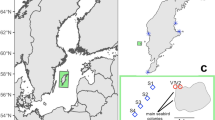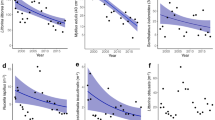Abstract
USING the submarine ALVIN, experiments on deep-sea benthic communities have been designed to follow the recolonisation of defaunated deep-sea sediments and to provide estimates of growth rates and time to maturity in individual species. Small brood size and the high proportion of adults in a number of deep-sea benthic taxa suggest relatively low rates of recruitment, growth and mortality in the deep sea1. Large individuals (8.4 mm) of the deep-sea bivalve, Tindaria callistiformis, have been estimated to be at least 100 yr old2. Measurements of microbial activity and community respiration indicate rates one to three orders of magnitude lower than in shallow water3,4. In contrast with the view that there is a general slowing of life processes, the first in situ deep-sea measurements on molluscan borers in wood panels have indicated rapid rates of recruitment, growth and maturation. Wood is, however, an ephemeral resource and its occurrence in the deep sea is unpredictable, while the majority of deep-sea habitats are thought to be highly predictable, therefore favouring less opportunistic life histories.
This is a preview of subscription content, access via your institution
Access options
Subscribe to this journal
Receive 51 print issues and online access
$199.00 per year
only $3.90 per issue
Buy this article
- Purchase on Springer Link
- Instant access to full article PDF
Prices may be subject to local taxes which are calculated during checkout
Similar content being viewed by others
References
Grassle, J. F. & Sanders, H. L. Deep-Sea Res. 20, 643–659 (1973).
Turekian, K. K. et al., Proc. natn. Acad. Sci. U.S.A. 72, 2829–2832 (1975).
Jannasch, H. W. & Wirsen, C. O. Science 180, 641–643 (1973).
Smith, K. L., Jr. & Teal, J. M. Science 179, 282–283 (1973).
Turner, R. D. Science 180, 1377–1379 (1973).
Grassle, J. P. & Grassle, J. F. Science 192, 567–569 (1976).
Grassle, J. F. & Grassle, J. P. J. mar. Res. 32, 253–284 (1974).
Hartman, O. & Fauchald K. Allan Hancock Monogr. mar. Biol. 6, 1–327 (1971).
Hartman, O. Zool. Anz. 167, 325–334 (1961).
Dayton, P. K. & Hessler, R. R. Deep-Sea Res. 19, 199–208 (1972).
Menge, B. A. & Sutherland, J. P. Am. Nat. 110, 351–369 (1976).
Jumars, P. A. J. mar. Res. 34, 217–246 (1976).
Author information
Authors and Affiliations
Rights and permissions
About this article
Cite this article
GRASSLE, J. Slow recolonisation of deep-sea sediment. Nature 265, 618–619 (1977). https://doi.org/10.1038/265618a0
Received:
Accepted:
Issue Date:
DOI: https://doi.org/10.1038/265618a0
This article is cited by
-
Recovery of Paleodictyon patterns after simulated mining activity on Pacific nodule fields
Marine Biodiversity (2021)
-
Recolonisation of new habitats by meiobenthic organisms in the deep Arctic Ocean: an experimental approach
Polar Biology (2012)
-
Directly measured rapid growth of a deep-sea barnacle
Nature (1990)
-
A response by benthic Foraminifera to the deposition of phytodetritus in the deep sea
Nature (1988)
-
In situ studies of megafaunal mounds indicate rapid sediment turnover and community response at the deep-sea floor
Nature (1986)
Comments
By submitting a comment you agree to abide by our Terms and Community Guidelines. If you find something abusive or that does not comply with our terms or guidelines please flag it as inappropriate.



